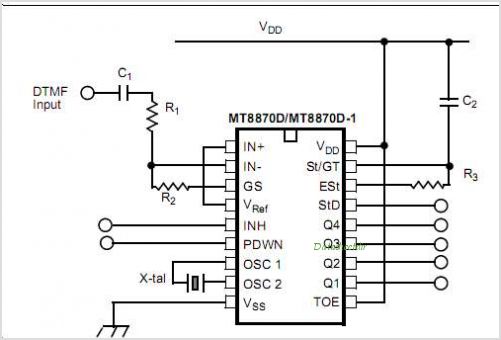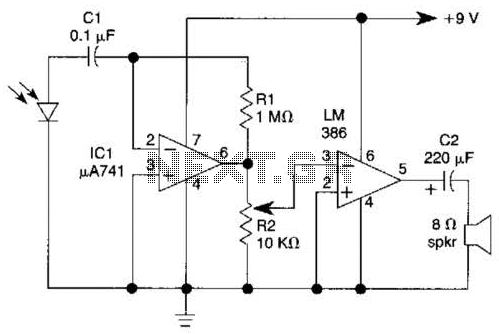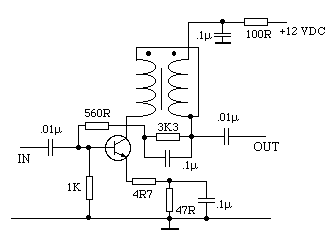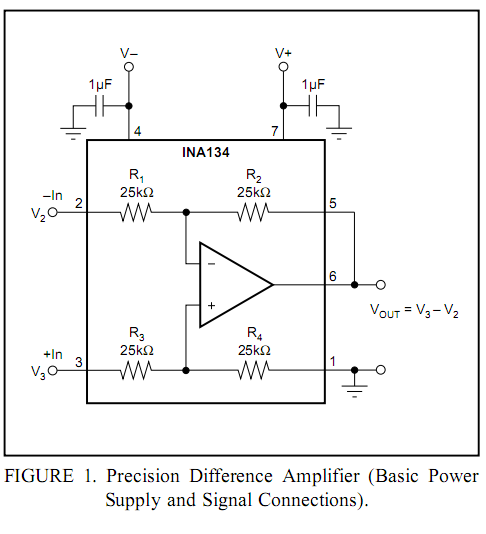
MT8870D Integrated DTMF Receiver With Enhance Sensitivity

The MT8885 is a monolithic DTMF transceiver equipped with a call progress filter. It is manufactured using CMOS technology, which ensures low power consumption and high reliability. The receiver section is designed based on the industry-standard MT8870 DTMF receiver. The transmitter employs a switched capacitor D/A converter to achieve low distortion and high accuracy in DTMF signaling. Internal counters enable burst mode operation, allowing tone bursts to be transmitted with precise timing. A call progress filter can be selected, enabling a microprocessor to analyze call progress tones. The MT8885 features an adaptive micro interface that permits connection to various popular microcontrollers with minimal external logic requirements. Additionally, the MT8885 offers enhanced power-down features, allowing the transmitter and receiver to be independently powered down via register control.
The MT8885 DTMF transceiver is an integrated solution that combines both transmission and reception of dual-tone multi-frequency (DTMF) signals, making it ideal for applications in telecommunications and remote control systems. The use of CMOS technology not only minimizes power consumption but also enhances the device's reliability, which is critical in battery-operated devices.
The architecture of the MT8885 includes a robust receiver section that accurately decodes incoming DTMF signals using the well-established MT8870 DTMF receiver design. This ensures compatibility with standard DTMF signaling used in telephone systems. The transmitter section, utilizing a switched capacitor D/A converter, guarantees minimal distortion and high fidelity of the transmitted tones, which is essential for maintaining signal integrity in communication systems.
The internal counters that facilitate burst mode operation are particularly valuable in applications where precise timing is crucial for signal transmission. This feature allows for efficient use of bandwidth and ensures that tone bursts are transmitted in a controlled manner, which is beneficial in reducing interference and improving overall communication quality.
The selectable call progress filter enhances the versatility of the MT8885, as it enables the analysis of call progress tones, such as ringing, busy, or dial tones. This capability is particularly useful for systems that require real-time feedback on the status of a call, allowing for more intelligent and responsive system designs.
The adaptive micro interface is a significant advantage, as it simplifies the integration of the MT8885 with various microcontrollers. This reduces the need for extensive external logic, streamlining the design process and minimizing the overall component count in the final application.
Furthermore, the enhanced power-down features allow for energy-efficient operation, as the device can be selectively powered down when not in use. This capability is critical in applications where power conservation is a priority, such as in portable or battery-operated devices.
Overall, the MT8885 DTMF transceiver provides a comprehensive solution for DTMF signaling needs, combining efficiency, reliability, and ease of integration into a wide range of electronic systems.The MT8885 is a monolithic DTMF transceiver with call progress Filter It is fabricated in CMOS technology offering low power consumption and high reliability. The receiver section is based upon the industry standard MT8870 DTMF receiver. The transmitter utilizes a switched capacitor D/A Converter for low distortion, high accuracy DTMF signalling.
Internal Counters provide a burst mode such that Tone bursts CAN be transmitted with precise Timing A call progress Filter CAN be selected allowing a Microprocessor to analyze call progress Tones The MT8885 utilizes an adaptive micro Interface which allows the device to be connected to a number of popular Microcontrollers with minimal external Logic The MT8885 provides enhanced power-down features. The transmitter and receiver may independently be powered down via Register control. 🔗 External reference
The MT8885 DTMF transceiver is an integrated solution that combines both transmission and reception of dual-tone multi-frequency (DTMF) signals, making it ideal for applications in telecommunications and remote control systems. The use of CMOS technology not only minimizes power consumption but also enhances the device's reliability, which is critical in battery-operated devices.
The architecture of the MT8885 includes a robust receiver section that accurately decodes incoming DTMF signals using the well-established MT8870 DTMF receiver design. This ensures compatibility with standard DTMF signaling used in telephone systems. The transmitter section, utilizing a switched capacitor D/A converter, guarantees minimal distortion and high fidelity of the transmitted tones, which is essential for maintaining signal integrity in communication systems.
The internal counters that facilitate burst mode operation are particularly valuable in applications where precise timing is crucial for signal transmission. This feature allows for efficient use of bandwidth and ensures that tone bursts are transmitted in a controlled manner, which is beneficial in reducing interference and improving overall communication quality.
The selectable call progress filter enhances the versatility of the MT8885, as it enables the analysis of call progress tones, such as ringing, busy, or dial tones. This capability is particularly useful for systems that require real-time feedback on the status of a call, allowing for more intelligent and responsive system designs.
The adaptive micro interface is a significant advantage, as it simplifies the integration of the MT8885 with various microcontrollers. This reduces the need for extensive external logic, streamlining the design process and minimizing the overall component count in the final application.
Furthermore, the enhanced power-down features allow for energy-efficient operation, as the device can be selectively powered down when not in use. This capability is critical in applications where power conservation is a priority, such as in portable or battery-operated devices.
Overall, the MT8885 DTMF transceiver provides a comprehensive solution for DTMF signaling needs, combining efficiency, reliability, and ease of integration into a wide range of electronic systems.The MT8885 is a monolithic DTMF transceiver with call progress Filter It is fabricated in CMOS technology offering low power consumption and high reliability. The receiver section is based upon the industry standard MT8870 DTMF receiver. The transmitter utilizes a switched capacitor D/A Converter for low distortion, high accuracy DTMF signalling.
Internal Counters provide a burst mode such that Tone bursts CAN be transmitted with precise Timing A call progress Filter CAN be selected allowing a Microprocessor to analyze call progress Tones The MT8885 utilizes an adaptive micro Interface which allows the device to be connected to a number of popular Microcontrollers with minimal external Logic The MT8885 provides enhanced power-down features. The transmitter and receiver may independently be powered down via Register control. 🔗 External reference





